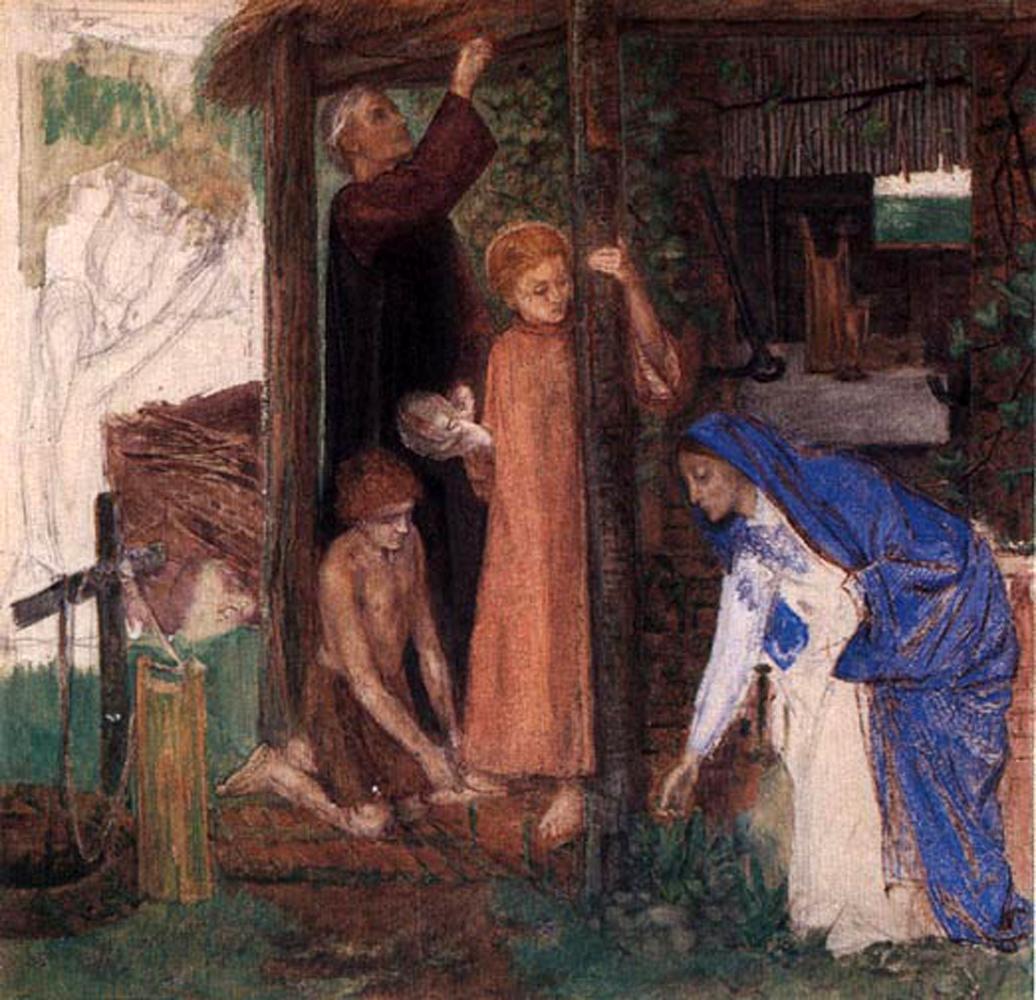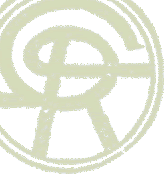A variant of this description was originally published at The Rossetti Archive at this location.
Dante Gabriel Rossetti describes this watercolour in his note to the accompanying poem (published in the 1870 Poems ): "The scene is in the house-porch, where Christ holds a bowl of blood from which Zacharias is sprinkling the posts and lintel. Joseph has brought the lamb and Elisabeth lights the pyre. The shoes which John fastens and the bitter herbs which Mary is gathering form part of the ritual." But not all of these details are in the picture, which DGR left unfinished: in particular, neither Joseph nor Elizabeth appear in the scene. Virginia Surtees' comments pick up other important details: "By the opening of the well on the extreme left two pieces of wood tied together with string form a Cross to which the water-cask is attached. The opening framed by a vine, behind the foreground figures, reveals a table in an interior, set with bread and wine" (vol. 1, 40). The model for the virgin was Elizabeth Siddal.
Like DGR's texts and pictures associated with the Virgin Mary, this work focuses on a crucial feature of Christian devotional symbolism. The point here is to represent the structure of typological symbolism. As is always the case with DGR, however, the approach is historicist and even ethnographic.
The responses to the poem of Coventry Patmore and John Ruskin (DGR had meant the painting for the latter) are extremely interesting and important. For Patmore, the picture's symbolism seemed vague and obscure, while for Ruskin there was no symbolism at all. As D. M. R. Bentley observes, however, both might have failed to grasp the symbolic structure because of its Catholic foundations, which are so antithetical to "the spirit of Protestant literalism" (28 ).
The picture thus helps to explain both the difference and the continuity between his early work, with its Christian preoccupations, and his later work, where pagan materials get more elaborated. DGR is interested in Christianity because it is a mythos of real spiritual presence and not of merely symbolic forms; and he is interested in "Pre-Raphaelite" or Medieval Christianity because he saw in that culture the signs of a belief in real spiritual presence. For DGR, the Renaissance (and its attendant religious reformations) represented a great collapse of spiritual values and the emergence of "soulless self-reflections of man's skill" in art and culture.
DGR's poem replicates what he told Patmore (in a letter of 7 November 1855) about the painting to which the poem refers: "Its chief claim to interest, if successful when complete, would be as a subject which must have occurred during every year of the life led by the Holy Family, and which I think must bear its meaning broadly and instantly—not as you say 'remotely'—on the very face of it—in the one sacrifice really typical of the other. In this respect—its actuality as an incident no less than as a scriptural type—I think you will acknowledge that it differs entirely from Herbert's some year's back, Millais' more recently" (see Fredeman, Correspondence, 55. 54 ). (This letter shows that DGR assumes Patmore's familiarity with typological symbolism.)
Textual History: Composition
The sonnet was written in September 1869 (see DGR's letter to WMR of 14 September where he says that he has sent “the printer 7 new sonnets†including this one: Fredeman, Correspondence, 69. 154 ). A fragment of a letter written to DGR's sister Maria on 10 September shows that he was seeking her help with details about the Passover ceremony. The manuscript in the Fitzwilliam Museum was printer's copy for the first printing in September 1869.
Production History
DGR did a first design in 1849, though its location is not known. In 1854, Ruskin saw two designs and commissioned one as a watercolour. By 1856, DGR had not finished it, as William Michael Rossetti told William Bell Scott in a letter ("He has on hand the subject, long since projected, of a Passover in the Holy Family" (see Peattie 63 ). This is presumably the version that Ruskin took away in its incomplete state, the received unfinished watercolour. Another different design was offered to Ruskin but rejected.
Iconographic
Like the picture it attends upon, the poem centers in the iconographical symbolism of Christian typology. In this symbolic structure events from the Old Testament prefigure New Testament events, as type to antitype. Cultic practices that celebrate the typological events thus carry, themselves, typological meanings. The system is ultimately founded on the Christian belief—derived from the Jewish idea of Messiah—that Jesus's life fulfilled the Old Testament promises associated with Messiah.
The patent symbolic character of the picture seemed "too remote and unobvious" to Patmore, and wholly nonsymbolic to Ruskin (William Michael Rossetti 139-40). Bentley shrewdly observes "that Rossetti's essentially Catholic conception of 'scriptural types' or figurae—learned, very likely, from Dante—is in direct opposition to the spirit of Protestant literalism" (28). All of the painting's accessories relate to the redemptive action that gets played out in the life and death of Jesus.
Literary
An important background text to the sonnet is the first chapter of Luke, and in particular the Benedictus of Zacharias, which is one of the most commonly cited prefigurative texts in the New Testament. The ritual of the Passover is set forth in Exodus 12:1-13.
Works Cited
Bentley, D. M. R. "Rossetti's 'Ave' and Related Pictures." Victorian Poetry 15.1 (1977): 21-35.
Fredeman, William E. The Correspondence of Dante Gabriel Rossetti. D. S. Brewer, 2002-2010.
Peattie, Roger. Selected Letters of William Michael Rossetti. Penn State UP, 2004.
The Pre-Raphaelites: A Catalogue for the Tate Exhibition. Tate Gallery/Penguin Books, 1984.
Rossetti, Dante Gabriel. Poems. 6th ed. F. S. Ellis, 1872.
Rossetti, William Michael. Ruskin: Rossetti: Preraphaelitism. Dodd, Mead and Company, 1899.
Surtees, Virginia. Painting and Drawings of Dante Gabriel Rossetti: A Catalogue Raisonné. vol. 1. Oxford: Oxford UP, 1971.
How to Cite this Web Page (MLA format)
McGann, Jerome. "Dante Gabriel Rossetti, Regina Cordium (1869)." Omnibus Edition of "In an Artist's Studio. Eds. Pamela Buck, Dino Franco Felluga, Nicole Fluhr, Dominique Gracia, Jerome McGann, Melissa Merte, and Herbert F. Tucker. The COVE: The Central Online Victorian Educator, covecollective.org. [Here, add your last date of access to The COVE].



